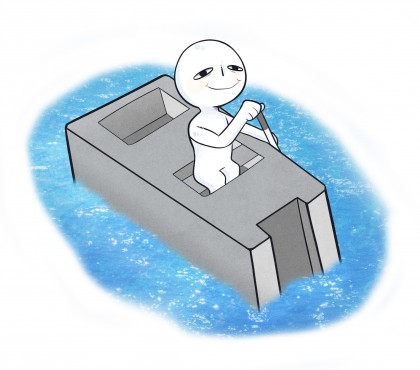When picturing a seaworthy canoe, concrete generally isn’t part of the equation. But for a group of University of Victoria Civil Engineering students, the idea’s starting to hold water.
The UVic Concrete Canoe team only formed last semester, but they have big ambitions for their project: building a 6.4-metre-long floating concrete canoe. “We got an email about it last semester from the Canadian Concrete Canoe Society,” said team president David Berry. “It was a really interesting project . . . We started seriously talking about it mid-October, [then] got the ball rolling middle of November.
“We actually poured concrete and got the testing done on the 21st of December right after our last exam. That was the first time anything material was put together. Before that it was just ideas and calculations.”
“It’s kind of the most ridiculous extreme you can do in [Civil Engineering],” said Leigh Borrett, the team’s Director of Communications & Media. “What’s something that will never float? OK, try to make it float.” But the team succeeded at just that on Jan. 20, when two of their three concrete mixes stayed afloat.
“The way we did that was we found this aggregate — the rocks that are in concrete — from a company called Poriver,” explained Berry. “It’s basically just puffed glass. There’s a lot of air in it even though it’s solid.” This air makes the concrete a lower density than the water surrounding it, making the concrete float.
Due to the process of displacement — when downward gravitational forces amount to less than the upward forces of buoyancy produced by a displaced volume of water — it’s not usually necessary for commercial boats to be comprised of buoyant material, but for the purposes of the 2016 Canadian National Concrete Canoe Competition ( hosted by McGill University from May 13–15), floating concrete is a must. “For this project we have to make the material float because as part of the competition they submerge your boat,” said Berry.
Although this line of work may seem ground-breaking, concrete canoe competitions are by no means brand new. In fact, UVic is rather late to the party. “It’s difficult because a lot of schools have had a civil program for over 20 years just doing the concrete canoe competition over and over again,” said Berry. “If they use their old stuff from last year, it’s super easy just to pound out another canoe, maybe change a little bit, but not much. [But at UVic] we’ve been doing everything totally from scratch.”
With the design and concrete mix of the canoe close to being finalized, the next step for the team is to turn their preliminary plans into reality. “The building process is going to be a huge task,” said Berry. “We’re hoping some of the younger [Civil Engineering] years can help us out.”
But the construction is only one step of the process. “[The concrete canoe project] is not restricted to just engineers, apart from the design,” said Borrett. “There’s a marketing and sponsorship component to it too, so [any] business students that are interested in getting involved, we’d welcome that for sure. If you’re enthusiastic enough, you should totally contact us and help out. Anyone can build.”
While it’s still up in the air how UVic will rank amongst the other experienced teams in May — Berry said their goal is a top five finish, while Borrett joked they’d be satisfied with nothing but first — they both have high hopes for UVic’s concrete canoeing future. “We’re hoping that we set the footprint, go and have fun, and the next civil year will take after us,” said Berry.









